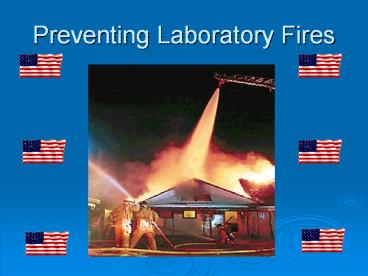Preventing Laboratory Fires - PowerPoint PPT Presentation
Title:
Preventing Laboratory Fires
Description:
Preventing Laboratory Fires – PowerPoint PPT presentation
Number of Views:118
Avg rating:3.0/5.0
Title: Preventing Laboratory Fires
1
Preventing Laboratory Fires
2
Agenda
- Flash over Video
- Laboratory Fire Loss
- Lab Fire Regulations
- Fire Safety Equipment
- General Safety Guidelines
3
Tri-State Flash over Video
4
Laboratory Fire Loss
- Structure Fires in Laboratories
- Annual Average
Incidents Fatalities Injuries Loss
1980-1994 532 1 24 7.0M
1995-1999 279 0 17 3.5M
5
Laboratory Fire Loss
- Extent of Flame Damage
- Confined to object of origin 153 55
- Confined to area of origin 65 23.3
- Confined to room of origin 29 10.2
- Confined to Fire-rated Compartment of
origin 4 1.4 - Confined to floor of origin 5 2.0
- Confined to structure 18 6.5
- Extended beyond structure 5 1.6
- 279 100
6
Laboratory Fire Loss
- Sprinkler Performance
- Operated 34 12.3
- Should have operated 6 2.1
- Fire too small 93 33.4
- None present 142 50.7
- Other 4 1.6
- 279 100
7
Laboratory Fire Loss
- Sprinkler Performance
- Operated 34 .46M 9.5
- Should have operated 6 .65M 13.5
- Fire too small 93 .45M 9.4
- None present 142 3.2M 65.7
- Other 4 .96M 2.0
- 279 4.82M 100
8
UNL Laboratory Fires
- Hamilton Hall September 1992
- Behlen Laboratory 2002
- Manter Hall oven fire June 2006
9
Hamilton Hall
- September 1992
- Explosion Rm. 619
- 30 year old Graduate student
- Solvent Distillation
- Tetrahydrofuran
- Chloroform
- Toluene
- Acid
10
Behlen Explosion 2002
- Explosion in ventilation hood, no fire or damage
to building - Occurred about 530 p.m.
- Nitric Acid
- Sulfuric Acid
- Acetone
11
Manter Hall
- Fire in baking oven 5-30-06
- Fire limited to oven
- Cause
- Didnt follow manufacture requirements.
- Oven too hot for contents.
12
Laboratory Fire Code Regulations
13
National Fire Protection Association (NFPA)
- NFPA 1 General Protection against Fire
- NFPA 10 Fire Extinguishers
- NFPA 30 Flammable and Combustible Liquids
- NFPA 45 Laboratories using Chemicals
- NFPA 70 National Electrical Code
- NFPA 101 Life Safety Code
14
International Fire Code (IFC)
- International Fire Code is approximately the same
as NFPA 1
15
Lab vs. Office
16
First Step
- Review of Current Chemicals.
- How much of these Chemicals do I have?
- What are the Hazards of these Chemicals?
17
Fire Safety Equipment
- Fire Sprinklers
- Fire Alarm Systems
- Fire Doors
- Fire Construction
- Emergency Lights
- Exit Paths
- Fire Extinguishers
18
Fire Sprinklers
- Serviced Annually.
- Storage 18 inches from ceiling.
- Non - Sprinklered buildings 24 inches from
ceiling.
19
Fire Alarms
- Inspected each 6 months
- Keep unobstructed
- Could Include
- Manual Pull Stations
- Heat Detectors
- Smoke Detectors
20
Fire Doors Close/Latch 703.2
- Fire doors and smoke barrier doors shall not be
blocked or obstructed or otherwise made
inoperable. - Allowed to have a magnetic hold open device.
21
Fire Door Protection
22
Fire Doors at Work
23
Fire Construction
- Determined by the classification of the
laboratory. - Varies depending on Hazards.
- Penetrations must be repaired or replaced.
24
Emergency Lights
- Tested monthly.
- Illuminate path of egress.
- Report damaged equipment.
25
Exit Signs
- Operational and properly Illuminated
- Report damaged equipment
26
Exit Paths
27
Fire Protection
28
General Fire Safety
- Flammable Liquid Storage
- Compressed Gas Cylinders
- Heat Sources
- Electrical Safety
- Ventilation and Vent Hoods
- Combustible Storage
29
Flammable Liquid Storage
- Requirement is based on quantities and hazard
ranking. - Located away from use and Ignition sources.
- More is NOT better.
30
Compressed Gas Cylinder
Compatibility of Gases Ignition Sources Storage
of Unused Cylinders
31
Heat Sources
32
Open Flames
33
(No Transcript)
34
Heat Sources
35
Hoods
36
(No Transcript)
37
Vent Hoods
- General Ventilation
- VS.
- Point Ventilation
38
Electrical Safety
39
Power Taps
40
Combustible Storage
Proper Storage Ceiling Clearance Electrical or
Heat Sources
41
Additional Hazards
42
Fire ExtinguisherPASS Method
43
(No Transcript)
44
Fire Extinguisher Service
45
Classes of Fire
- Class A Fires are ordinary materials such as
burning paper, lumber, cardboard, and plastics. - Class B Fires involve flammable or combustible
liquids such as gasoline, kerosene, and common
organic solvents used in the laboratory setting.
46
Classes of Fire
- Class C Fires involve energized equipment such
as appliances, switches, panel boxes, and power
tools. Water can be a dangerous extinguishing
medium for class c fires because of the risk of
electrical shock. - Class D Fires involve combustible metals, such
as magnesium or titanium.
47
Fight-or-Flight Checklist
- The building is being evacuated.
- The fire department is being called.
- The fire is small, contained and not spreading
beyond its starting point. - The exit is clear, and you can fight the fire
with your back to the exit.
48
Fight-or-Flight Checklist
- You can stay low and avoid smoke.
- The proper extinguisher is immediately at hand.
- You have read the instructions and know how to
use the extinguisher.
49
REVIEW
- Flash over Video
- Laboratory Fire Loss
- Lab Fire Regulations
- Fire Safety Equipment
- General Safety Guidelines
50
Additional Information
- Environmental Heath and Safety (EHS) (402)
472-4925, ehs_at_unl.edu - University of Nebraska Virtual Manual
http//ehs.unl.edu/vmanual/ - State Fire Marshals Office (402) 471-2027
- In Lincoln, Bureau of Fire Prevention (402)
441-7791
51
Hazard of the Week
52
Questions































